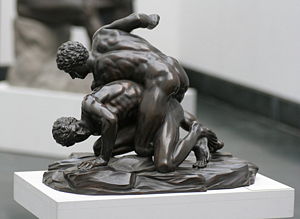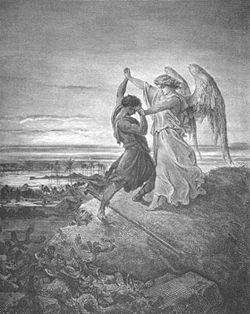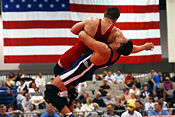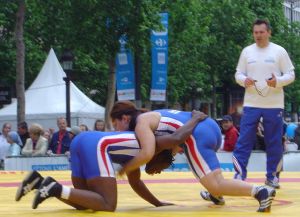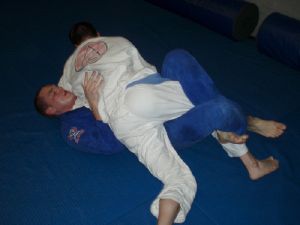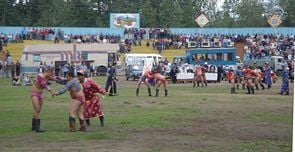Wrestling
Wrestling is the act of physical engagement between two unarmed persons, in which each wrestler strives to get an advantage over or control of his opponent.
Physical techniques which embody the style of wrestling are clinching, holding, locking, and leverage. Avoiding potentially lethal techniques, wrestling has aspects of ritual fighting, but its basic principles are closely related to those of military hand-to-hand combat or self-defence systems. Many styles of wrestling are known all over the world and have long histories, and sport wrestling (particularly amateur wrestling) has become an Olympic sport.
History
Ancient
Middle and Far East
The Epic of Gilgamesh in Sumerian literature features its hero Gilgamesh establishing his credibility as a leader after wrestling Enkidu. Other sculptures and literature from ancient Mesopotamia show that wrestling was held in popularity.[1] One other early (probably circa 1500 B.C.E.) description of wrestling appears in the Old Testament book of Genesis 32:22-32. The passage depicts the patriarch Jacob wrestling with the Angel, for which Jacob was subsequently renamed Israel. (Israel translates to "wrestles (or strives) with God".)[2]
The Mahabharata, one of the major Sanskrit epics of ancient India, describes the encounter between the accomplished wrestlers of Bhima and Jarasandha; "grasping each other in various ways by means of their arms, and kicking each other with such violence as to affect the innermost nerves, they struck at each other's breasts with clenched fists. With bare arms as their only weapons roaring like clouds they grasped and struck each other like two mad elephants encountering each other with their trunks".[3] The popular folk wrestling style of India performed on a mud surface called the akhara follows the Indian tradition.
Shuai Jiao, a wrestling style originating in China, is arguably the most ancient of all Chinese martial arts, with a reported history of over 4,000 years. (The date may be legendary, but wrestling was reportedly used by the Yellow Emperor during his fight against the rebel Chih Yiu and his army in 2697 B.C.E.) During these matches, the combatants reportedly wore horned helmets that they used to gore their opponents while using a primitive form of grappling. This early style of combat was first called Jiao Ti (butting with horns). Throughout the centuries, the hands and arms replaced the horns while the techniques increased and improved. The name Jiao Ti also changed over time, both through common usage and government decree.[4]
Mediterranean
The first documented evidence of wrestling in Egypt appeared circa 2300 B.C.E., on the tomb of the Old Kingdom philosopher Ptahhotep. During the period of the New Kingdom (2000-1085 B.C.E.), additional Egyptian artwork (often on friezes), depicted Egyptian and Nubian wrestlers competing. Carroll notes striking similarities between these ancient depictions and those of the modern Nuba wrestlers.[5] On the 406 wrestling pairs found in the Middle Kingdom tombs at Beni Hasan in the Nile valley, nearly all of the techniques seen in modern freestyle wrestling could be found.[6]
During the period of Ancient Greece (about 1100 to 146 B.C.E.), Greek wrestling was a popular form of martial art in which points were awarded for pinning a competitor by stretching the opponent prone to the ground or touching his back to the ground, forcing a competitor to submit or by forcing a competitor out of bounds (arena).[7] Three falls determined the winner. It was at least featured as a sport since the eighteenth Olympiad in 704 B.C.E. Wrestling is described in the earliest celebrated works of Greek literature, the Iliad and the Odyssey.[8] Wrestlers were also depicted in action on many vases, sculptures, and coins, as well as in other literature. Other cultures featured wrestling at royal or religious celebrations, but the ancient Greeks structured their style of wrestling as part of a touranment where a single winner emerged from a pool of competitors.[9] Greek mythology celebrates the rise of Zeus as ruler of the earth after a wrestling match with his father, Kronos. Both Herakles and Theseus were famous for their wrestling against man and beast. Late Greek tradition also stated that Plato was known for wrestling in the Isthmian games.[10]
This continued into the Hellenistic period. Ptolemy II and Ptolemy III of Egypt were both depicted in art as victorious wrestlers. After the Roman conquest of the Greeks, Greek wrestling was absorbed by the Roman culture and became Roman wrestling during the period of the Roman Empire (510 B.C.E. to AD 500).[citation needed] Arabic literature depicted Muhammad as a skilled wrestler, defeating a skeptic in a match at one point. By the eighth century, the Byzantine emperor Basil I, according to court historians, won in wrestling against a boastful wrestler from Bulgaria.[11]
Middle Ages
In 1520 at the Field of the Cloth of Gold pageant, Francis I of France threw Henry VIII of England in a wrestling match.[12] In Henry VIII's kingdom, folk wrestling in many places was widely popular and had a long history. In particular, the Lancashire style may have formed the basis for Catch wrestling also known as "catch as catch can." The Scots later formed a variant of this style, and the Irish developed the "collar-and-elbow" style which later found its way into the United States.[13] The French developed the modern Greco-Roman style which was finalized by the 19th century and by then, wrestling was featured in many fairs and festivals.[14]
Modern
Because of that and the rise of gymnasiums and athletic clubs, Greco-Roman wrestling and modern freestyle wrestling were soon regulated in formal competitions. On continental Europe, prize money was offered in large sums to the winners of Greco-Roman tournaments, and freestyle wrestling spread rapidly in the British Isles and in the United States after the American Civil War. Professional wrestling soon increased the popularity of Greco-Roman and freestyle wrestling around the world with such competitors as Georg Hackenschmidt, Kara Ahmed, Paul Pons, Stanislaus Zbyszko, William Muldoon, and Frank Gotch.[15][16] When the Olympic games resurfaced at Athens in 1896, Greco-Roman wrestling was introduced for the first time. After not being featured in the 1900 Olympics, sport wrestling was seen again in 1904 in St. Louis; this time in freestyle competition. Since then, Greco-Roman and freestyle wrestling have both been featured, with women's freestyle added in the Summer Olympics of 2004. Since 1921, the International Federation of Associated Wrestling Styles (FILA) has regulated amateur wrestling as an athletic discipline, while professional wrestling has largely become infused with theatrics.[17]
Etymology
The term wrestling is an Old English word that originated some time before 1100 C.E. It is perhaps the oldest word still in use in the English language to describe hand-to-hand combat.[18] The Merriam-Webster online dictionary defines wrestling as 'a sport or contest in which two unarmed individuals struggle hand-to-hand with each attempting to subdue or unbalance the other'.[19]
Roget's New Millennium Thesaurus does not support the usage of 'wrestling' (noun) and 'grappling' (noun) as synonymous. [20]
International disciplines (Non-Folk Styles)
Wrestling disciplines defined by FILA, are broken down into two categories; International wrestling disciplines and folk wrestling disciplines. According to the International Federation of Associated Wrestling Styles, there are five current International wrestling disciplines acknowledged throughout the world. They are Greco-Roman wrestling, freestyle wrestling, Sambo, Grappling and Beach wrestling.[21]
Greco-Roman
Greco-Roman is an international discipline and an Olympic sport. "In Greco-Roman style, it is forbidden to hold the opponent below the belt, to make trips, and to actively use the legs in the execution of any action." Recent rule changes in Greco-Roman increase opportunities for and place greater emphasis on explosive, 'high amplitude' throws. One of the most well known Greco-Roman wrestlers from the United States is Rulon Gardner.[22]
Freestyle
Freestyle wrestling is an international discipline and an Olympic sport. "In free style, it is allowed to hold the legs of the opponent, to make trips and to use actively legs on the execution of any action."[23] It is thought to have originated from English catch wrestling, and is currently the international style in which women participate in competition.
Sambo
Sambo is a martial art that originated in the Soviet Union (particular Russia) in the 20th century. It is an acronym for "self-defence without weapons" in Russian and had its origins in the Soviet armed forces. Its influences are varied, with techniques borrowed from sports ranging from the two international styles of Greco-Roman and freestyle to boxing, judo, jujitsu, European styles of folk wrestling, and even fencing. The rules for sport sambo are similar to those allowed in competitive judo, with a variety of leglocks and with over 5,000 defense holds from the various national wrestling styles in the Soviet Union, while not allowing chokeholds.[24]
Grappling
"Grappling, also called submission wrestling, refers to the gripping, handling, and controlling of an opponent without the use of striking, typically through the application of various grappling holds and counters to various hold attempts. Grappling can be used in both a standing position, where it is known as stand-up grappling, and on the ground, where it is known as ground grappling. Grappling is an essential part of both clinch fighting and ground fighting".[25] Grappling is also used to describe the skills used in mixed martial arts competitions, differing from the FILA definition.
Beach wrestling
Apparently in a bid to give wrestling greater appeal to television audiences, FILA adopted beach wrestling as an official discipline during 2004-2005. Beach wrestling is standing wrestling done by wrestlers, male or female, inside a sand-filled circle measuring 6 meters in diameter. There are only two weight categories, heavy and light. The objective is to throw your opponent or take your opponent to his or her back. The wrestlers wear swimsuits rather than special wrestling uniforms. Wrestlers may also wear spandex or athletic shorts.[26][27]
Folk Style Disciplines
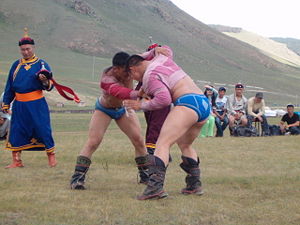
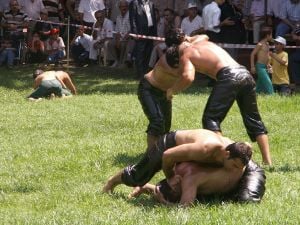
There are almost as many folk wrestling styles as there are national traditions, because folk wrestling describes a traditional form of wrestling unique to a culture or geographic region of the world. Folk wrestling styles are not recognized by FILA internationally. The following list provides examples of wrestling systems that fall into this category.
| Discipline | Origin |
|---|---|
| Mallayuddha, Pehlwani | India |
| Pahlavani | Iran |
| Böke | Mongolia |
| Catch wrestling | United Kingdom |
| Sambo | Russia |
| Brazilian Jiu-Jitsu | Brazil |
| Collegiate Wrestling | United States |
| Glima | Iceland |
| Gouren | France |
| Khuresh | Mongolia |
| Lucha Canaria | Spain |
| Lucha Leonesa | Spain |
| Luta Livre | Brazil |
| Schwingen | Switzerland |
| Shoot wrestling | Japan |
| Shuai jiao | China |
| Ssireum | Korea |
| Submission Wrestling | Greece |
| Sumo | Japan |
| Yağlı güreş | Turkey |
Collegiate wrestling
Collegiate wrestling (sometimes known as scholastic wrestling or folkstyle wrestling) is the commonly used name of wrestling practiced at the college and university level in the United States. A very similar style is practiced at the high school and middle school levels, and also for younger participants. The term is used to distinguish the styles of wrestling used in other parts of the world, and for those of the Olympic Games: Greco-Roman wrestling, and Freestyle wrestling. There are currently several organizations which oversee collegiate wrestling competition: Divisions I, II, and III, of the NCAA, NJCAA, NAIA, and the NCWA. Division I of the NCAA is considered the most prestigious and challenging level of competition. A school chooses which organization to join, although it may compete against teams from other levels and organizations during regular-season competition. The collegiate season starts in November and culminates with the NCAA tournament held in March.
Professional Wrestling
While professional wrestling featured undeniable feats of athleticism and performers often utilized traditional wrestling holds early in its history from the decades of the 70's, 80's and 90's with only some newly invented moves, today it is a true competition seeing as competitors put their bodies on the line in a match whether it is a singles or a partner match. It also involves feuds and angles, mainly like all other wrestling promotions, which create a wide promotional spot for big events to get held at big venues like Madison Square Garden.
As a martial art
Wrestling has gained respect among martial arts practitioners, especially with the advent of mixed martial arts competition.[28] Early competitions (e.g. UFC 4 & 5) saw wrestlers defeat stylists from more traditional, striking-oriented styles such as karate and kickboxing. Randy Couture (current UFC heavyweight champion) and Dan Henderson (current PRIDE champion in both the 183 and 205 pound divisions) both competed extensively in collegiate and Greco-Roman wrestling before beginning their careers in mixed martial arts. Other fighters coming from wrestling are: Matt Lindland, Matt Hughes, Sean Sherk, Urijah Faber, Tyson Griffin, Kevin Randleman, Mark Kerr, Don Frye, Mark Coleman, Brian Vettel, Tito Ortiz, Quinton Jackson, Rashad Evans, Jeff Monson, Matt Horwich.
Many other prominent and successful fighters began their training in various forms of wrestling, and fighters from non-wrestling backgrounds often pursue wrestling training to complement their other skills.
See also
- Amateur wrestling
- Arm wrestling
- Grappling
- List of famous amateur wrestlers
- List of professional wrestlers
- Mixed martial arts
- Pankration
| ||||||||||||||||||||
Notes
- ↑ "Wrestling, Freestyle" by Michael B. Poliakoff from Encyclopedia of World Sport: From Ancient Times to the Present, Vol. 3, pp. 1189, 1193, eds. David Levinson and Karen Christensen (Santa Barbara, CA: ABC-CLIO, Inc., 1996).
- ↑ Poliakoff, Michael B. "Jacob, Job, and Other Wrestlers," Journal of Sport History, Summer 1984, v. 11:2, pp. 48-55.
- ↑ The Mahabharata, SECTION XXIII, p. 51
- ↑ http://www.kuoshu.co.uk; see also Peiser, Benny, "Western Theories about the Origins of Sport in Ancient China," Sports Historian, May 1996, v. 16, 117-139.
- ↑ Carroll, Scott T. "Wrestling in Ancient Nubia," Journal of Sport History, Summer 1988, v. 15:2, pp. 121-137. http://www.aafla.org/SportsLibrary/JSH/JSH1988/JSH1502/jsh1502b.pdf]
- ↑ "Wrestling, Freestyle" by Michael B. Poliakoff from Encyclopedia of World Sport: From Ancient Times to the Present, Vol. 3, p. 1189, eds. David Levinson and Karen Christensen (Santa Barbara, CA: ABC-CLIO, Inc., 1996).
- ↑ Historical Pankration Wrestling
- ↑ "Wrestling, Freestyle" by Michael B. Poliakoff from Encyclopedia of World Sport: From Ancient Times to the Present, Vol. 3, pp. 1189, 1191, eds. David Levinson and Karen Christensen (Santa Barbara, CA: ABC-CLIO, Inc., 1996).
- ↑ "Wrestling, Freestyle" by Michael B. Poliakoff from Encyclopedia of World Sport: From Ancient Times to the Present, Vol. 3, p. 1189, eds. David Levinson and Karen Christensen (Santa Barbara, CA: ABC-CLIO, Inc., 1996).
- ↑ "Wrestling, Freestyle" by Michael B. Poliakoff from Encyclopedia of World Sport: From Ancient Times to the Present, Vol. 3, p. 1193, eds. David Levinson and Karen Christensen (Santa Barbara, CA: ABC-CLIO, Inc., 1996).
- ↑ "Wrestling, Freestyle" by Michael B. Poliakoff from Encyclopedia of World Sport: From Ancient Times to the Present, Vol. 3, p. 1193, eds. David Levinson and Karen Christensen (Santa Barbara, CA: ABC-CLIO, Inc., 1996).
- ↑ "Wrestling, Freestyle" by Michael B. Poliakoff from Encyclopedia of World Sport: From Ancient Times to the Present, Vol. 3, p. 1193, eds. David Levinson and Karen Christensen (Santa Barbara, CA: ABC-CLIO, Inc., 1996).
- ↑ "Wrestling, Freestyle" by Michael B. Poliakoff from Encyclopedia of World Sport: From Ancient Times to the Present, Vol. 3, p. 1190, eds. David Levinson and Karen Christensen (Santa Barbara, CA: ABC-CLIO, Inc., 1996).
- ↑ Greco-Roman Wrestling. FILA (2007-01-01). Retrieved 2007-08-09.
- ↑ "Wrestling, Freestyle" by Michael B. Poliakoff from Encyclopedia of World Sport: From Ancient Times to the Present, Vol. 3, p. 1190, eds. David Levinson and Karen Christensen (Santa Barbara, CA: ABC-CLIO, Inc., 1996).
- ↑ "Wrestling, Greco-Roman" by Michael B. Poliakoff from Encyclopedia of World Sport: From Ancient Times to the Present, Vol. 3, p. 1194, eds. David Levinson and Karen Christensen (Santa Barbara, CA: ABC-CLIO, Inc., 1996).
- ↑ "Wrestling, Freestyle" by Michael B. Poliakoff from Encyclopedia of World Sport: From Ancient Times to the Present, Vol. 3, p. 1190, eds. David Levinson and Karen Christensen (Santa Barbara, CA: ABC-CLIO, Inc., 1996).
- ↑ Wrestling etymology
- ↑ Merriam-Webster Online Dictionary
- ↑ [http://thesaurus.reference.com/browse/wrestling dictionary.reference.com American Psychological Association (APA): wrestling. (n.d.). Roget's New Millennium Thesaurus, First Edition (v 1.3.1). Retrieved March 23, 2007, from Thesaurus.com]
- ↑ International Federation of Wrestling Styles
- ↑ FILA-Greco-Roman definition
- ↑ FILA-Freestyle definition
- ↑ FILA-Sambo definition
- ↑ FILA-Grappling definition
- ↑ FILA beach wrestling rules[1]
- ↑ Gary Mihoces, "Wrestling's New World Rises from Sand," USA Today, July 11, 2005.[2]
- ↑ Krauss, Erich (1 Dec 2004). Warriors of the Ultimate Fighting Championship. U.S.: Citadel Press Inc.,. ISBN 0806526572.
ReferencesISBN links support NWE through referral fees
- Poliakoff, Michael (1996), "Wrestling, Freestyle", in Christensen, Karen, Encyclopedia of World Sport: From Ancient Times to the Present, vol. 3, Santa Barbara, CA: ABC-CLIO, Inc., at 1189-1193, ISBN0874368197
- Poliakoff, Michael (1996), "Wrestling, Greco-Roman", in Christensen, Karen, Encyclopedia of World Sport: From Ancient Times to the Present, vol. 3, Santa Barbara, CA: ABC-CLIO, Inc., at 1194-1196, ISBN0874368197
Credits
New World Encyclopedia writers and editors rewrote and completed the Wikipedia article in accordance with New World Encyclopedia standards. This article abides by terms of the Creative Commons CC-by-sa 3.0 License (CC-by-sa), which may be used and disseminated with proper attribution. Credit is due under the terms of this license that can reference both the New World Encyclopedia contributors and the selfless volunteer contributors of the Wikimedia Foundation. To cite this article click here for a list of acceptable citing formats.The history of earlier contributions by wikipedians is accessible to researchers here:
The history of this article since it was imported to New World Encyclopedia:
Note: Some restrictions may apply to use of individual images which are separately licensed.
